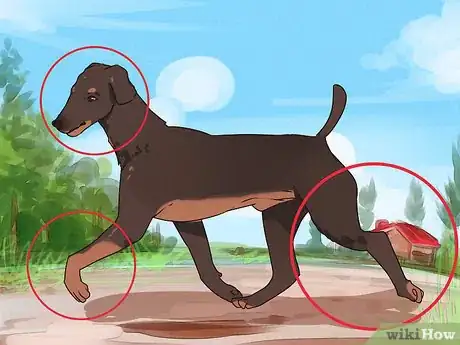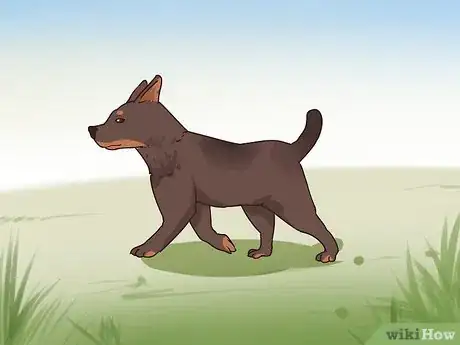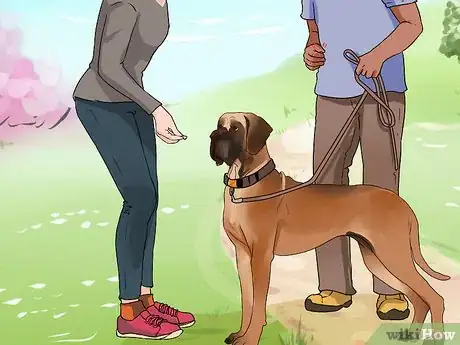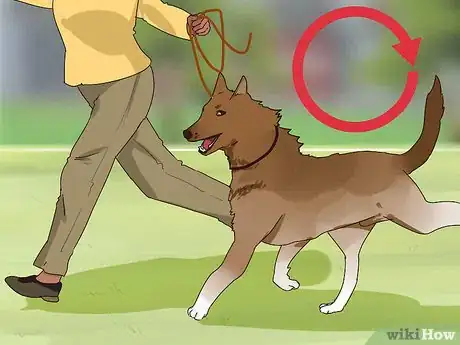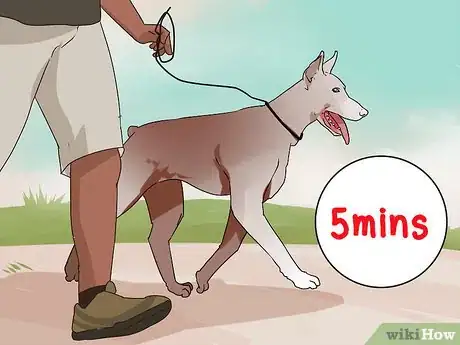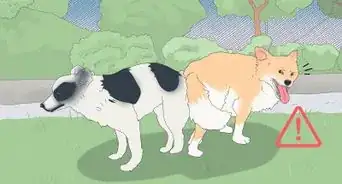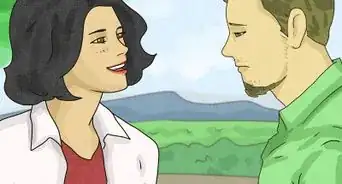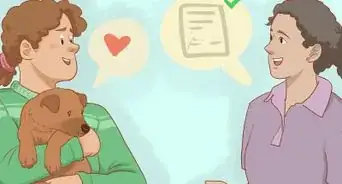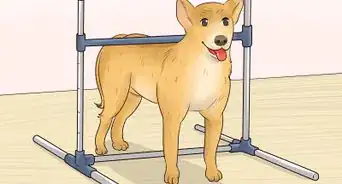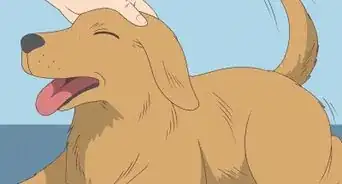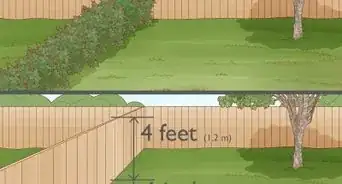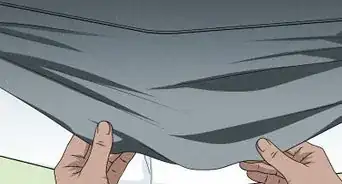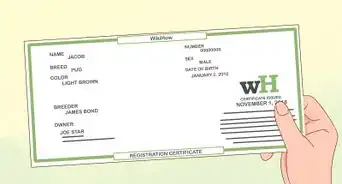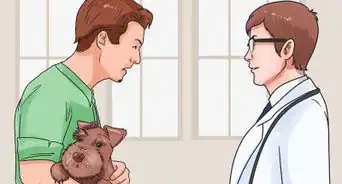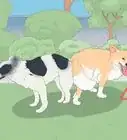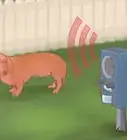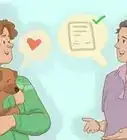This article was co-authored by wikiHow Staff. Our trained team of editors and researchers validate articles for accuracy and comprehensiveness. wikiHow's Content Management Team carefully monitors the work from our editorial staff to ensure that each article is backed by trusted research and meets our high quality standards.
There are 9 references cited in this article, which can be found at the bottom of the page.
This article has been viewed 21,595 times.
Learn more...
Improving your dog's show ring gait is best done by a qualified professional in a controlled setting. However, if you wish to improve your dog's show ring gait, you can do so at home if you have plenty of time and patience. Observe your dog's show ring gait and decide what needs improvement using feedback from a dog show judge or your own judgement. Adopt a clicker and reward system that lets your dog know when they are gaiting properly. Then, train your dog to gait in the way you wish, starting without a leash and then moving over to leash training when they improve.
Steps
Adhering to General Rules
-
1Use the collar and leash you'll use during the show. If you use one type of collar and leash during training and a totally different type of leash and collar during the show, your puppy might get confused. To avoid this, use the same collar and leash during the show that you'll be using in the show ring.[1]
- If you need to make a change to your dog's collar or leash due to show rules or for any other reason, do so during training.
-
2Decide what needs improvement. A dog's show ring gait is comprised of several discrete elements. Identify whether your dog's straight-line movement, left and right turns, amble, or trot need work.[2]
- Your dog's gait might also need to be adjusted based on its relation to the leash. If your dog pulls the leash too tightly, it will not walk properly.
Advertisement -
3Correct one aspect at a time. If your dog's show ring gait needs several corrections – for instance, perhaps your dog's speed and distance from you are wrong – only take on one correction at a time. Adjusting your dog's show ring gait in even one way can be difficult. Therefore, the best approach is to take only one thing at a time. After your dog has corrected one aspect of its show ring gait, begin adding other elements that you want it to correct.[3]
-
4Do not tease or bait your dog. Waving food around in front of your dog or getting your dog wound up will not help your training process. You should be teaching your dog that the clicker is the reward, not the treat itself.[4]
-
5Reward your dog. When your dog assumes a show-ring appropriate gait, reward it in two ways. First, click the clicker or whatever clicker substitute you've adopted for training purposes. Second, administer a treat. The treat you use is up to you. Your dog might, for instance, enjoy a cube of cheese or a slice of ham.[5]
-
6Train your dog early. Younger dogs have an easier time correcting their show ring gait than older dogs. When improving your dog's show ring gait, begin as early as possible.[6]
Choosing Your Methods and Techniques
-
1Enroll your dog in classes. Once you know exactly how you want your dog's show ring gait improved, you will be able to take corrective action. The best way to improve your dog's show ring gait is to sign it up for classes. Contact your local kennel club about enrolling your dog in classes to improve show ring gait. If they don't offer classes, ask a club representative if they know of a local trainer or club that does offer classes.
- If you continue to struggle trying to find classes for your dog, check online or use your yellow pages to find an instructor.
-
2Obtain a clicker. A clicker is a small device, available at most pet stores, to help your dog associate good behavior with a reward. However, it is not necessary to use a clicker manufactured for the specific purpose of dog training. You could instead use a whistle, a bell, or any other noisemaker. The important thing is to keep the clicker or clicker substitute consistent throughout training, otherwise your dog could be confused.[7]
-
3Find a partner. It is easier to engage in clicker training if you give your dog a treat while another person utilizes the clicker, or vice versa. Ask a family member or friend to help you improve your dog's show ring gait. Alternately, locate someone else who is also interested in improving their dog's show ring gait. That way, you and the other person can take turns helping each other improve your dogs' show ring gaits.[8]
- With a partner, one of you can stand in a central position observing from a distance with a clicker, while the other one can walk along the dog holding its leash and administering treats when as needed.
- If you don't want to work with a partner, just hold the clicker in one hand and the treats in your other hand.
Attempting a General Gait Correction
-
1Teach your dog to follow along your left side. With your dog off-leash, hold a treat in your left hand. Look behind your left shoulder as you walk. When you see your dog following you, click and give it a treat. Ensure as you give it a treat that its head remains up and facing forward.[9]
-
2Leash the dog. Once your dog successfully learns to walk along your left side, and understands why it is being rewarded, put your dog on a leash. The leash should be held in such a way that it does not drag on the ground between you and your dog. Hold the clicker and leash in your left hand and the treats in your right. Continue the training as before, rewarding only proper form with treats and clicks.[10]
-
3Correct your dog's gait as you go. If your dog is trained incorrectly, it will only cause another problem that will require retraining later. If you notice your dog not perfectly adhering to your gait-correction training, take immediate action to correct it. For instance, if your dog is veering off course or running rather than walking, say “Oops!” or “Uh-oh!” in a friendly way. Return with the dog to your starting point and try again.[11]
- Do not reward your dog for pulling or veering off course.
-
4Repeat as needed. Improving your dog's show ring gait is a process. Your dog's show ring gait will not improve with just one or two training sessions. For some dogs, improvement will take longer than it might for others. But for all dogs, you will need to invest a significant amount of time in the training process.[12]
- Use random intervals between training sessions, otherwise your dog might come to associate performing an appropriate gait with a certain time (for instance, right when they wake up).
- For instance, if you wish to teach your dog to keep its head up to improve its show ring gait, perform a head-up exercise with your dog, then again 15 minutes later, then again five minutes after that.
-
5Keep your training sessions short. Do not push yourself or your dog too hard when training. Working in sessions of five minutes or less several times per day should be sufficient to improve your dog's show ring gait.[13]
References
- ↑ http://www.pedigreedatabase.com/articles.html?s=training-the-german-shepherd-dog-for-the-show-ring
- ↑ http://www.showdogs.org/NipissingKC/showtrain2.htm
- ↑ http://www.whole-dog-journal.com/issues/12_10/features/Positive-Training-For-Show-Dogs_16168-1.html
- ↑ http://www.showdogs.org/NipissingKC/showtrain2.htm
- ↑ http://www.showdogs.org/NipissingKC/showtrain2.htm
- ↑ http://www.pedigreedatabase.com/articles.html?s=training-the-german-shepherd-dog-for-the-show-ring
- ↑ http://www.showdogs.org/NipissingKC/showtrain2.htm
- ↑ http://www.showdogs.org/NipissingKC/showtrain2.htm
- ↑ http://www.whole-dog-journal.com/issues/12_10/features/Positive-Training-For-Show-Dogs_16168-1.html
- ↑ http://www.whole-dog-journal.com/issues/12_10/features/Positive-Training-For-Show-Dogs_16168-1.html
- ↑ http://www.whole-dog-journal.com/issues/12_10/features/Positive-Training-For-Show-Dogs_16168-1.html
- ↑ http://www.showdogs.org/NipissingKC/showtrain2.htm
- ↑ http://www.showdogs.org/NipissingKC/showtrain2.htm
About This Article
To improve your dog’s show ring gait, choose one aspect to work on at a time, such as its speed or distance from you, to avoid confusing it. When you’ve chosen an aspect to work on, take your dog for a walk on its leash and whenever it fails to adhere to the aspect you’re training, return to the starting point and try again. You can also say something like ‘Oops’ to signal that it was wrong. When your dog’s form is correct, make sure to reward it with a treat. Additionally, you can use a clicker to reinforce good behavior by clicking it whenever you give your dog a treat. For more tips, including how to decide which aspects of your dog’s gait to train, read on!

